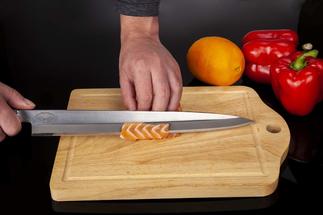
Best Damascus Kitchen Knives and Chef’s Knives
Posted by Best.Buy. Damascus1 on
There are so many different types of kitchen knives on the market today. Many of them claim that they can improve your cooking experience. An increasingly popular choice is Damascus Kitchen Knife. What is a Damascus knife? How much easier can it make your preparation for cooking?
Let’s take a look at the details and benefits of Damascus kitchen and chef’s knives, which you should pay attention to when buying one, the best knives on the market and how you can care for them after purchase.
Best Damascus Kitchen Knives and Chef’s Knives
Let’s look at some of my favorite Damascus chef’s and kitchen knives.
Master Damascus Chef’s knife
This beautiful knife is custom made by Damascus1 Knives. The blade measures 7.5 inches and has a warbled design. The handle has green wood, golden accents, a copper bolster and has a solid, well-designed feel.
Pros:
- Each knife is handmade by artisans.
- A leather case is included to protect the blade when it is not in use.
- Each knife is well oiled out of the box so that it will not rust during application.
- Two options are available: D2 steel or 440C steel. The 440C steel is made of stainless steel, which is rust-resistant.
Cons:
- There may be imperfections and imperfections in the metal, due to the handmade nature of the knife.
Infinity Chef Knife
This chef’s knife from Damascus1 Infinity has a simple and elegant look. The blade has a wavy design, measures eight centimeters and is made of 67 layers of Japanese steel. The dark handle is simple, but elegant, with a lot of weight in the hand.
Pros:
- The appearance of the knife is simplistic and slim.
- 67 layers of Japanese steel give the knife stability, strength and durability.
- The knife is stain and corrosion resistant.
- There is minimal resistance during cutting, making preparing every meal easy and fast.
- The knife is non-stick, so you can keep cutting or chopping without stopping to pull ingredients from the knife.
- Stainless steel helps the knife to prevent rust.
- The handle is riveted to the tongs with mosaic rivets. This adds strength and durability.
- The handle is rounded for a comfortable and secure grip.
- The handle is resistant to moisture, heat and shock, making the knife last longer.
Cons:
- The knife contains carbon steel and stainless steel. Although stainless steel is rust-resistant, high-carbon steel is more susceptible to rust. To be sure, you should wash and dry the knife as soon as you are done and keep it oiled.
- The knife can feel heavy and unbalanced, making it difficult for some people to use it.
- It is not recommended to chop. The curve at the back of the knife makes it difficult to use the entire length of the knife for chopping.
- The blade can develop rust and chips after prolonged use.
- It should be sharpened regularly every three days.
This chef’s knife is made of Japanese steel and has a black sheath. It is vacuum treated and has a hammered surface. The knife measures eight centimeters with a sharp edge and mirror gloss. It is a very beautiful knife, almost decorative.
Strong Chef’s Knife
This chef’s knife is made of Japanese steel and has a black sheath. It is vacuum treated and has a hammered surface. The knife measures eight centimeters with a sharp edge and mirror gloss. It is a very beautiful knife, almost decorative.
Pros:
- The knife has a very sharp edge, making it useful to cut something, even tough meat.
- It is finished by hand and polished at 8-12 degrees per side. This is done with a traditional method, the three-step method. This reduces the resistance during cutting and prevents food from getting stuck on the knife.
- It is nitrogen-cooled, which increases flexibility and corrosion resistance.
- The knife is triple riveted and has full forceps for resilience and stability.
- It is balanced for ease of use.
- The G10 black handle of military quality is hand-polished, durable, comfortable, ergonomic and resistant to heat, cold and moisture.
- A black sheath is included to protect your knife.
Cons:
- The carbon-rich steel can be sensitive to rust. The blade must be washed, dried and oiled after each use.
- The metal is relatively soft and can therefore be chipped.
- The knife feels heavy and out of balance.
- The edge seems uneven.
Handmade Damascus Chef’s Knife
The blade of this chef’s knife, made by the Damascus1, is made of stainless steel and has a swirled design. The handle is made of walnut. The blade measures seven inches, for a total length of 12 centimeters.
Pros:
- The stainless steel blade is resistant to rust and stains.
- The walnut handle is strong and durable.
- The handle is bent so that it can adjust to your hand for a comfortable and secure grip during use.
- Three rivets attach the handle to the tongs of the blade.
Cons:
- Care instructions for the knife recommend keeping it away from all moisture and oiling it often. Although this is a good method for every knife, it can also mean that the steel is not as rust-resistant as it should be.
Executive Chef knife
This Damascus chef’s knife is the Executive Chef range of Infinity. The blade measures eight centimeters and has a twisted design. It has 67 layers of Japanese steel, a tsuchime finish and an air knife design. It combines the beauty of Japanese steel with the weight and power of German knives. However, like many other Damascus knives, it feels a bit heavier than normal in your hand.
Pros:
- The Japanese steel is stainless, strong and durable.
- The ultra-deep blade measures 57 millimeters, which ensures knuckle freedom and efficiency when sawing.
- The knife is non-sticky, so you can cut or chop without stopping to “remove” food from the knife.
- A Rockwell hardness rating of 61 ensures that your knife can withstand shocks and last a lifetime.
- The knife is resistant to rust, stains and corrosion.
- The handle is strong and durable. It is triple riveted to the full forceps for extra strength and stability.
- The rounded handle and the tapered bolster offer comfort when sawing.
Cons:
- The knife is not as sharp as expected.
- The knife is not sharpened evenly.
- The handle is too short and feels difficult to hold.
- The edge does not stay sharp for long.
- The knife feels heavy, making it difficult to use.
Santoku Chef’s knife
This Santoku chef’s knife from Damascus1 has a Damascus handle and a wooden handle. The blade measures 6.5 inches, for a total length of 12 inches. The handle is made of black walnut. It is flat with a slight curve. The general feeling in your hand is professional and comfortable.
Pros:
- Damascus steel is strong, durable and beautiful.
- The handle has a slight curve, making it comfortable to hold while cutting.
- Stainless steel pins attach the handle to the tongs of the blade.
Cons:
- The blade must be kept away from all moisture and well oiled. It rusts very easily, even within an hour after washing. For this reason, it must be immediately thoroughly dried and stored in a completely dry location.
- The knife does not have an even edge and has an opening in the middle of the knife.

